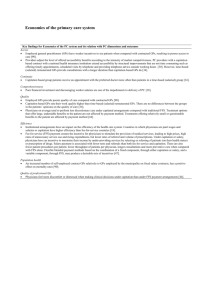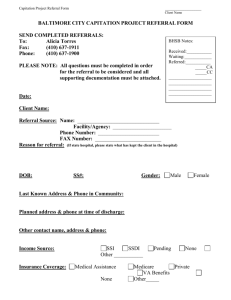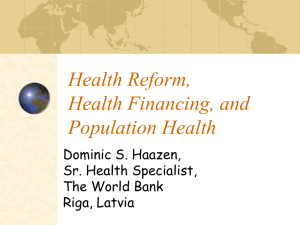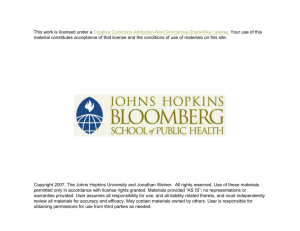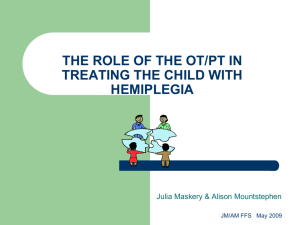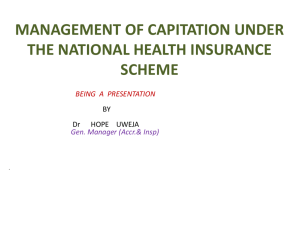A study of universal access and separatist primary care systems 1
advertisement
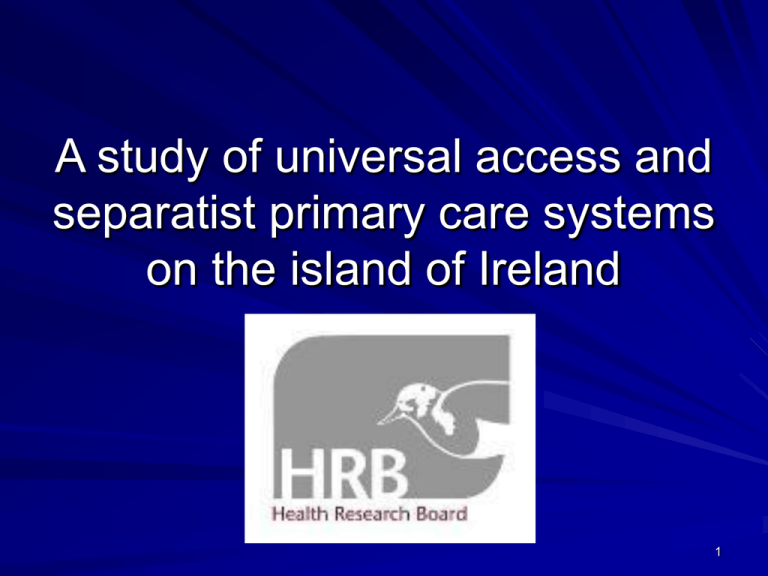
A study of universal access and separatist primary care systems on the island of Ireland 1 Project Team Queen’s University Belfast NUI Galway Dr. Dermot O’Reilly • Dr. Keith Steele • Dr. Drew Gilliland • Ms. Karen Thompson • Professor Andrew W Murphy • Mrs. Ethna Shryane • University Of Ulster • Professor Ciaran O’Neill Trinity College Dublin • Professor Tom O’Dowd • Dr Alan Kelly University College Dublin • Professor Gerry Bury 2 Original research questions (N vs S) Question 1. Does health status differ between patients ? Yes; south are healthier Question 2. How do patients view the issue of cost? In south: good idea; in north, not so Question 3. Does a co-payment effect health seeking behaviour? Yes; very much so in the south Question 4. Does patient satisfaction differ ? Yes; south are more satisfied 3 Post hoc question (south only) Question 5. Are primary care services different for those who pay? i.e. GMS (capitation) vs private patients (FFS) 4 The effects of capitation and fee for service on the consultation process: a cross sectional study and associated dissemination issues 5 Background literature Payment systems – Prospective: Salary and capitation – Retrospective: Fee for service (FFS) – Mixed Market theories – Supplier Induced Demand (SID) – Consumerism Cochrane review (2000) – 4 studies of 6, 400 patients; 2 children only – Concerns regarding generalisability and confounding esp. health status and patient satisfaction – Need for further standardised and prospective studies 6 Study hypotheses 1. That GP initiated visits will be higher in FFS in comparison to capitation patients 2. That prescription, investigation and referral rates will all be higher in FFS in comparison to capitation patients 3. That satisfaction with communication will be higher in FFS in comparison to capitation patients 7 The Island of Ireland Ireland: 30% free (low income & 70+yrs): Capitation 70% pay (€35-55): Fee for service ‘FFS’ 8 Methodology 1st Phase - Baseline survey 20 practices in Ireland, 20 in N.Ireland (matched) 625 patients randomly selected from lists Postal survey (Autumn 2003; 2 reminders): RR 52% 2nd Phase – Audit of consultations (Ireland only) Random selection of up to 200 survey respondents per practice Random selection of 1 consultation per patient Up to 4 outcomes categorised per consultation & summarised; - Prescription (Yes/No) - Investigation (Yes/No) - Referral (Yes/No) 9 Study instruments Health status – Limiting long term illness (LLTI) – Perceived general health – Case finding for depression Classification of ‘GP initiated’ or not Process outcome – Prescription; investigation; referral 10 Study Instruments: GP Assessment Questionnaire Dimensions of patient satisfaction: Continuity of Care Patient / Doctor Communication Access to services Overall Satisfaction Receptionists Nursing * © The National Primary Care Research and Development Centre, University of Manchester and Safran/NEMCH 11 Questions that form the communication scale of the General Practice Assessment Questionnaire Thinking about consulting with your doctor, how would you rate the following: 1. How thoroughly your doctor asks about your symptoms? 2. How well your doctor listens to what you say? 3. How well the doctor puts you at ease during your physical examination? 4. How much the doctor involves you in decisions about your care? 5. How well your doctor explains your problems or treatments you need? 6. The amount of time your doctor spends with you? 7. Doctor’s patience with your questions or worries? 8. Doctor’s caring and concern for you? 12 Methods Analysis – Logistic regression with robust confidence intervals to account for clustering within practices Ethical approval from ICGP 13 Results 1, 668 patients from 20 practices – – – – Mean age 34.7 (SD 19.5) 62.6% female 28.4% capitation and 70.4% FFS Education 1O: 24.3%; 2O: 43.2%;3O 29.8% – Car ownership None: 14.7%; One: 39.0%; 2+cars: 45.7% – 77.4% owner occupier – LLTI: Yes 24.5% – Depression: Yes 38.4% 14 Structure of Data in South Survey respondents (5,291; RR 52%) Random Selection (3, 351) Patients aged 20-69 yrs who consulted during 12 mth period (2, 584; 77.1%) Prescription (993; 59.5%) Investigation (239; 14.3%) Referral (237; 14.2%) 15 Study hypotheses 1. That GP initiated visits will be higher in the FFS group in comparison to the capitation group Total mean consultation rate – Capitation 6.0 (n = 693); FFS 3.6 (n = 548) – Mean difference 2.38 (95% CI 1.90-2.87) Initiation: GP 11.1% and Patient 85.8% – FFS 9.6% – Capitation 14.6% 16 Logistic regression determinant of having a GP initiated visit Adjusting for sex, age, general health, LLTI, Depression, GMS eligibility, household income and geography Only GMS eligibility significant: – Capitation – FFS 1.00 0.56 (95% CI 0.37-84) 17 Study hypotheses 1. That GP initiated visits will be higher in the FFS group in comparison to the capitation group 2. That prescription, investigation and referral rates will all be higher in FFS patients in comparison to capitation patients 18 Prescription, investigation and referral rates by age 70 60 % 50 0-19 40 20-44 45-69 30 20 10 0 Prescriptions (p=ns) Investigations (p<0.001) Referrals (p<0.001) 19 Prescription, investigation and referral rates self-reported general health 70 Excellent Very Good Good Fair/Poor 60 50 % 40 30 20 10 0 Prescriptions (p=0.002) Investigations (p=0.044) Referral (p=0.036) 20 Prescription, investigation and referral rates by payment status 70 Captiation (GMS) Fee for service (Non-GMS) 60 50 % 40 30 20 10 0 Prescription (p<0.001) Investgation (p<0.001) Referral (p=ns) 21 Logistic regression determinants of being issued a Rx CI’s P value 1.60 1.27-2.02 < 0.001 Good 1.59 1.22-2.10 0.001 Fair/Poor 1.31 0.94-1.82 0.109 General health Excellent Adj OR Very good 1.00 22 Logistic regression determinants of being issued a Rx GMS status Capitation Adj OR FFS 0.75 CI’s P value 0.66-0.85 < 0.001 1.00 23 Logistic regression determinants of being investigated GMS status Capitation Adj OR FFS 2.26 CI’s P value 1.50-3.40 0.001 1.00 24 Logistic regression determinants of being referred Adj OR CI’s P value 25 Study hypotheses 1. That GP initiated visits will be higher in the FFS group in comparison to the capitation group 2. That prescription, investigation and referral rates will all be higher in FFS patients in comparison to capitation patients 3. That satisfaction with communication will be higher in FFS patients in comparison to capitation patients 26 Logistic regression determinants of a high communication score CI’s P value 0.70 0.53-0.93 0.014 40-49 0.57 0.42-0.78 < 0.001 50-59 0.64 0.44-0.93 0.020 60-69 0.86 0.59-1.25 0.433 Age Adj OR 20-29 1.00 30-39 27 Logistic regression determinants of a high communication score CI’s P value 0.76 0.56-1.03 0.740 Good 0.48 0.34-0.68 < 0.001 Fair/Poor 0.52 0.35-0.77 0.001 General health Excellent Adj OR Very good 1.00 28 Logistic regression determinants of a high communication score GMS status Capitation Adj OR FFS 0.79 CI’s P value 0.66-0.95 0.014 1.00 29 Logistic regression determinants of a high communication score Process Adj OR Not Ix’ed 1.00 Ix’ed 1.29 CI’s P value 1.01-1.65 0.038 30 Discussion Limitations – – – – Cross sectional study: ‘Association, not causation’ Retrospective determination of consultation initiation Long term, not acute, health status All GP’s receive mixed payments Strengths – Mixed is reflective of international practice – Clustering accounted for during analysis – Relatively large (n=1, 668) study in nationally representative sample – Disaggregated consultation data with potential confounders included 31 Study hypotheses 1. That GP initiated visits will be higher in FFS in comparison to capitation patients FFS OR 0.75 95%CI 0.66-0.85 2. That prescription, investigation and referral rates will all be higher in FFS vs capitation Rx: FFS OR 0.75 95%CI 0.66-0.85 Ix: FFS OR 2.26 95%CI 1.50-3.40 Referral: 3. That satisfaction with communication will be higher in FFS in comparison to capitation FFS OR 0.79 95%CI 0.66-0.95 32 Why so ? Madden and Nolan (2005) Use of Rx and Ix by GP’s Omission of confounders from previous work, Scott (1995) Stable Irish system vs US ‘before + after’ Uni-dimensional economical approach – ‘businessman with licences’- insufficent 33 Incentivisation vs professionalism Timmins, 2005 – ‘the professionalism of GP’s will have to be played off against their financial self interest’ 120 100 80 60 Marshall, 2005 40 – ‘crowding out’ 20 Score 0 0 1 2 3 4 5 6 34 Conclusions Prescription and investigation patterns indicate that the method of GP remuneration does impact upon the process of the consultation. SID does not appear to explain the differences between payment status; rather GPs may be more concerned with their patients’ ability to pay, than with opportunities for income generation. 35 Dissemination issues JE Pirkis, GA Blashki, A W Murphy, JC Richards, IB Hickie, L Ciechomski. The contribution of general practice based research to the development of national policy: Two international case studies. Submitted AusNZ Health Policy Journal 36 Publishing record Question 1. Does health status differ between patients ? Rejected: Eur J Pub Hlth, Soc Sci Med Currently: IJMS Question 2. How do patients view the issue of cost? Rejected: Health Affairs Currently: Hth Economics Question 3. Does a co-payment effect health seeking behaviour? Rejected: BMJ, Family Practice Currently: EJGP Question 4. Does patient satisfaction differ ? Currently: Family Practice 37 Research into policy Lavis, 2003 – ‘producer-push’ (where producers of research actively push research knowledge out to users of research), – ‘user-pull’ (where users of research actively pull in research when faced with a decision that they believe could be informed by research knowledge) and – ‘knowledge exchange’ (where producers and users of research are jointly responsible for transferring and facilitating the uptake of research knowledge, and elements of ‘producer push’ and ‘user pull’ approaches occur) 38 Dissemination Innvaer (2002): systematic review of of policy-makers’ views on using research evidence for policy decisions. Facilitators x7 – – – – – – – personal contact between researchers and policy-makers timeliness and relevance of the research summary with clear recommendations good quality research confirmed current policy or endorsed self-interest community pressure or client demand for research included effectiveness data Barriers x6 – absence of personal contact between researchers and policymakers – lack of timeliness or relevance – mutual mistrust, including perceived political naivety of scientists and scientific naivety of policy-makers – power and budget struggles – poor quality of research – political instability or high turnover of policy-makers 39 FFS vs capitation paper Where to send to ? – Probably a secondary issue, for us ? Have decided not to wait for publication – attempted to get HRB to sponsor meeting – will persist with some prior dissemination Sustenance from Int Cmmttee Med – http://www.icmje.org/ The ideal is Lomas, 2000 – ‘linkage and exchange’, that routine and ongoing involvement of policy-makers in the activities of research organisations will improve the likelihood of research influencing policy. 40 Acknowledgements HRB Participating GP’s and practices 41
